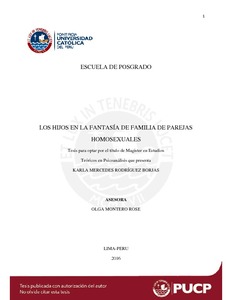| dc.contributor.advisor | Montero Rose, Olga | |
| dc.contributor.author | Rodríguez Borjas, Karla Mercedes | es_ES |
| dc.date.accessioned | 2017-04-10T14:40:21Z | es_ES |
| dc.date.available | 2017-04-10T14:40:21Z | es_ES |
| dc.date.created | 2016 | es_ES |
| dc.date.issued | 2017-04-10 | es_ES |
| dc.identifier.uri | http://hdl.handle.net/20.500.12404/8356 | |
| dc.description.abstract | El objetivo de la presente investigación es conocer qué lugar ocupan los hijos en la fantasía de
familia producidas por la pareja homosexual, al encontrarse frente a una alternativa cada vez más
accesible de reproducción asistida. Esto nos permite entender la organización del futuro de estas
parejas cuando la posibilidad de hijo puede ser una realidad. Para ello se utilizó una metodología
cualitativa desde la teoría psicoanalítica, mediante entrevistas y gráficos con parejas
homosexuales. Participaron nueve parejas (cinco de hombres y cuatro de mujeres) las cuales
tenían más de dos años conviviendo. Surge del análisis temático, tres ejes: uno en el que aparece
la fantasía de hijo en la fantasía latente y manifiesta, otro en el que aparece la fantasía de hijo
solo en la fantasía latente y un tercero dónde no aparece la fantasía de hijo. Los resultados
apuntan a que el diálogo con el futuro en las parejas homosexuales, se hace mediante la aparición
de los hijos en la fantasía de familia, los cuales toman distintas formas de acuerdo a la
estructuración psíquica de la pareja. | es_ES |
| dc.description.abstract | The aim of this research is to understand the place of children in family fantasies that the
homosexual couple engenders, when confronted with the increasingly affordable choice of
assisted reproduction. These discoveries will allow us to understand these couples’ future
organization in situations when the possibility of a child could become a reality. To conduct this
research we applied psychoanalytic theory, qualitatively, by means of interviews and graphical
stimuli. Nine gay couples with more than two years of cohabitation were studied (five male and
four female). The thematic analysis presents three axes: in the first, the fantasy of having a child
appears in the latent and manifest discourse; in the second, the fantasy of having a child appears
only in the latent fantasy; in the third, the fantasy of having a child does not appear. The results
of the study suggest that the dialogue with the future in homosexual couples is made through the
appearance of children in the family fantasy, which take different forms according to the psychic
structuring of the couple. | es_ES |
| dc.language.iso | spa | es_ES |
| dc.publisher | Pontificia Universidad Católica del Perú | es_ES |
| dc.rights | info:eu-repo/semantics/openAccess | es_ES |
| dc.rights.uri | http://creativecommons.org/licenses/by-nc-nd/2.5/pe/ | * |
| dc.subject | Homosexualidad | es_ES |
| dc.subject | Fantasía | es_ES |
| dc.subject | Familia | es_ES |
| dc.subject | Relaciones de pareja | es_ES |
| dc.subject | Niños | es_ES |
| dc.title | Los hijos en la fantasía de familia de parejas homosexuales | es_ES |
| dc.type | info:eu-repo/semantics/masterThesis | es_ES |
| thesis.degree.name | Maestro en Estudios Teóricos en Psicoanálisis | es_ES |
| thesis.degree.level | Maestría | es_ES |
| thesis.degree.grantor | Pontificia Universidad Católica del Perú. Escuela de Posgrado | es_ES |
| thesis.degree.discipline | Estudios Teóricos en Psicoanálisis | es_ES |
| renati.discipline | 313107 | es_ES |
| renati.level | https://purl.org/pe-repo/renati/level#maestro | es_ES |
| renati.type | http://purl.org/pe-repo/renati/type#tesis | es_ES |
| dc.publisher.country | PE | es_ES |
| dc.subject.ocde | https://purl.org/pe-repo/ocde/ford#5.01.00 | es_ES |






